Glaciers
Steven Dutch, Professor Emeritus, Natural and Applied Sciences, University of Wisconsin - Green Bay
Glacier: a Flowing Stream of Ice
- Mountain
- Continental (Greenland, Antarctica)
Snowfall vs Melting & Evaporation (Ablation)
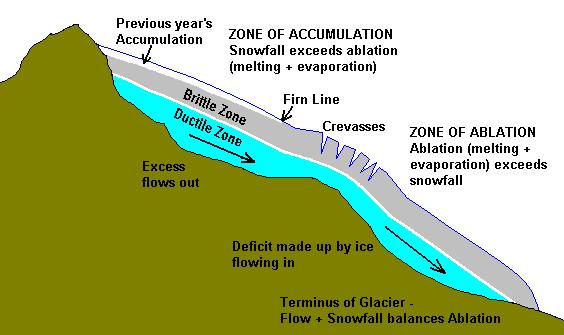
Zone of Accumulation
- Snowfall Exceeds Melting & Evaporation
- Excess Snow Turns to Ice & Flows Out
Zone of Melting or Ablation
- Melting & Evaporation Exceeds Snowfall
- Melting Excess Made up by Ice Flowing in
Terminus of Glacier
Snowfall & Inflow = Melting & Evaporation (Ablation)
Results of Glaciation
Abrasion
- Polish
- Striations
- Chatter Marks
- Crescentic Gouges
- Bedrock Scour
Deposition
- Till
- Outwash
- Varved Clays
Meltwater Erosion
Glacial Landforms
Mountain Glacier Landforms
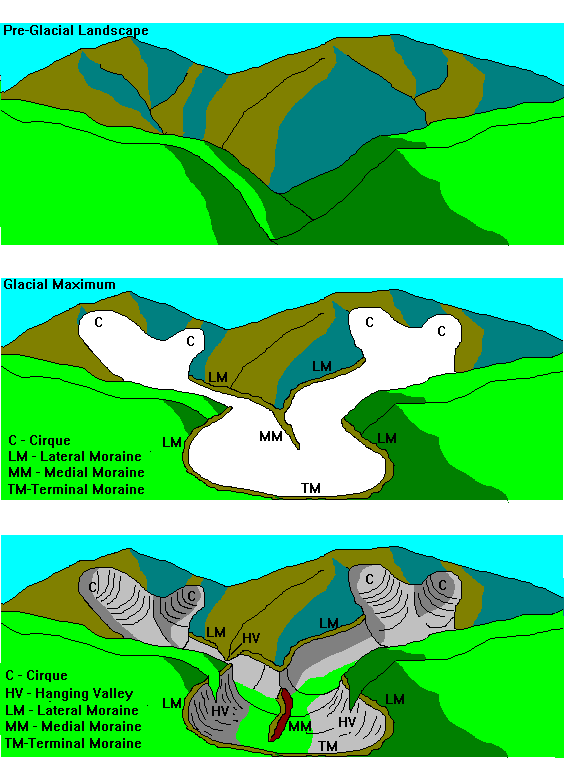
Evolution of a typical mountain glacier landscape.
Continental Glacier Landforms
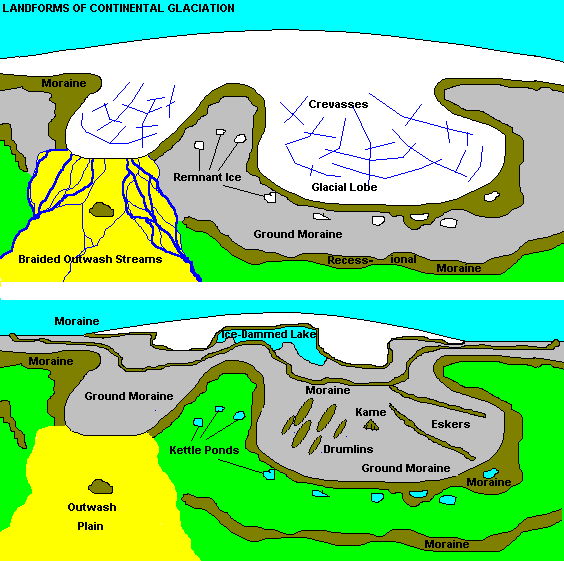
Two stages in the retreat of a typical continental glacier.
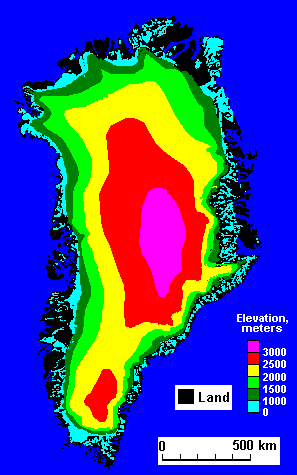 |
The Greenland Ice Cap shows the dome-like form of a typical continental glacier. |
Glacial Chronology
The table below gives an idea how complex the Pleistocene really was. Ice advances and retreats in different areas are given different names because it is not always certain that they began at the same time everywhere.
| Time (1000 Years) | Conditions | North America | Alps | Northern Europe | Poland-Russia |
| 0-18 | Interglacial | ||||
| 18-67 | Glacial | Wisconsin | Wurm | Vistula | Varsovian |
| 67-128 | Interglacial | Sangamon | Uznach | Eem | Masovian |
| 128-180 | Glacial | Illinoisan | Riss | Warthe/Saale | Cracovian |
| 180-230 | Interglacial | Yarmouth | Hoetting | Holstein | Sandomirian |
| 230-300 | Glacial | Kansan | Mindel | Elster | Jaroslavian |
| 300-330 | Interglacial | Aftonian | Cromer | Likhvin | |
| 330-470 | Glacial | "Nebraskan" | Gunz | Menapian | |
| 470-540 | Interglacial | Waalian | |||
| 540-550 | Glacial | Donau II | Weybourne | ||
| 550-585 | Interglacial | Tiglian | |||
| 585-600 | Glacial | Donau I | |||
| 600-2000 | About 20 Glacial Advances | ||||
| 2000 (2 M.Y.) | Beginning of Pleistocene | ||||
| 4000 (4 M.Y.) | Dwarf forests still in Antarctica | ||||
| 15 M.Y. | First Glaciation in Antarctica | ||||
Ice Ages
- Pleistocene 3 M.y.
- Permian 250-220 M.y.
- Ordovician 450 M.y.
- Precambrian
- 900-650 M.y. (Snowball Earth)
- 2300 M.y.
- Earth seems to have alternated between "icehouse" and "greenhouse" episodes.
The Greenhouse Effect
- "A little greenhouse effect is a good thing" (Carl Sagan). Without a natural greenhouse effect, earth would be frozen.
- 90% of the earth's natural greenhouse effect is due to water vapor.
- Ever notice how hot nights are sticky? It's no accident - it's hot because it's sticky. High humidity results in a water-vapor greenhouse effect.
- In summer, both New Orleans and Phoenix might hit 100 F, but by midnight Phoenix could be down to 60, whereas New Orleans might still be 90. The difference is due to humidity and a water-vapor greenhouse effect.
- We can't do much about evaporation from the oceans, but we have been adding to the atmospheric load of carbon dioxide.
- Other important greenhouse gases are methane and oxides of nitrogen.
- Molecule for molecule, methane is twenty times more powerful than carbon dioxide as a greenhouse gas.
- Landfilling garbage (which releases methane) instead of burning it may not always be the best idea.
- Some scientists have proposed that abrupt warming episodes in earth's past may have been triggered by releases of methane.
The Carbonate-Silicate Cycle
- Earth has almost as much carbon dioxide as Venus
- Volcanoes add carbon dioxide to the atmosphere
- Carbon dioxide is removed from the air to make carbonate rocks
- Mountain-building favors cooling
-
- Uplift exposes rocks to weathering
- Calcium silicates (plagioclase, amphiboles, pyroxenes) are chemically weathered
- Calcium is carried to the sea where organisms bind it into carbonate minerals
- Creation of carbonates removes carbon dioxide from the atmosphere
- Weathering of carbonates returns carbon dioxide to the atmosphere
- Plate tectonics carries some carbonates into the earth
-
- Heat liberates carbon dioxide
- Carbon dioxide returns to the atmosphere
- The cycle does not require life but does require liquid water.
- Uplift of the Himalayas resulted in delivery of huge volumes of sediment to the oceans, perhaps lowering carbon dioxide and helping to trigger cooling.
The Snowball Earth
Between 900 and 600 m.y. ago, Earth froze completely (or almost) about four times. Global freezing alternated with extremely rapid sea-level rise and global warming
Evidence:
- Glacial deposits on all continents, even at low latitudes
- Glacial deposits immediately succeeded by thick deposits of carbonate rocks
Possible reasons:
- Fainter early sun - the early sun was perhaps 30 per cent less bright than today. At the time of the snowball earth it was perhaps 5 per cent less bright. Over most of earth's history temperatures have been above freezing, implying that the atmosphere had a stronger greenhouse effect than at present.
- Biological changes? Possibly appearance of new types of organisms took more CO2 out of the atmosphere
Probable Sequence of Events
- Global ice cover. The more ice, the more sunlight reflected to space.
- Weathering and erosion shut down, so the removal of carbon dioxide to make carbonate rocks ceases
- Volcanoes continue to erupt CO2
- At 10% CO2, abrupt warming begins
- There is rapid melting, abrupt sea level rise, and rapid deposition of carbonate rocks as excess carbon dioxide reacts with calcium in the oceans. Some lines of evidence suggest temperatures went from –50 C to +50 C in 10,000 years or less.
- Implications for life? How did anything survive? Were there ice-free places? Did life survive at submarine hot springs? Was there a mass extinction, clearing the way for the abrupt appearance of Cambrian life forms?
Milankovich Cycles
Cool Summers More Important Than Cold Winters
Axis Tilt
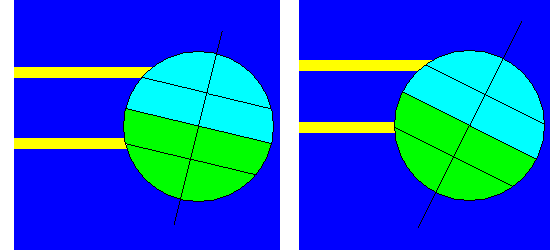
- Small Axis Tilt: Mild winters but cool summers. Favors Ice Age
- Large Axis Tilt: Cold winters but hot summers. Favors Interglacial
Shape of Orbit + Precession
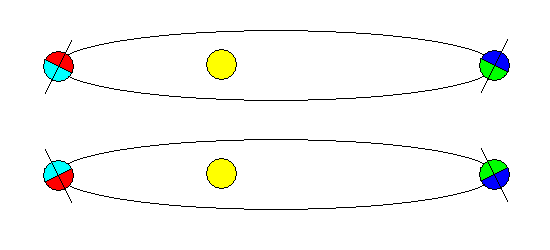
- Summer at Aphelion (Eccentric Orbit)
- Near-circular Orbit
- Mild winters but cool summers. Favors Ice Age
- Summer at Perihelion (Eccentric Orbit)
- Cold winters but hot summers. Favors Interglacial
Where We Stand Now, And a Mystery
- Earth's axial tilt is decreasing. It was about 24.5 degrees 9,000 years ago and will reach a minimum of amount 22.5 degrees in about 10,000 years. The tropics are retreating toward the equator at about 1.7 mm/hour. During a typical class period, the tropics move about twice the diameter of a pencil lead. The decreasing axial tilt favors an ice age.
- We reach aphelion in July. That favors cool summers, hence an ice age.
- The shape of the earth's orbit favors an interglacial.
The earth's axial tilt reached a maximum about 9,000 years ago and was increasing for 20,000 years before that. The increasing tilt would have favored hotter summers, hence ice retreat. Just like sunlight reaches maximum in June, but summer is hottest in August, there's a time lag.
The mystery. The roughly 100,000 year period of ice ages corresponds most closely to a 100,000 year cycle in the shape of the earth's orbit. Yet the variation in sunlight between January (perihelion) and July (aphelion) is trivial compared to the seasonal variations due to the tilt of the earth's axis, and the changes in distance from the sun are tinier yet. Nobody has yet figured out how the shape of the earth's orbit translates into climate change.
What Causes Ice Ages?
Within Earth (Endogenic)
- Carbonate-Silicate Cycle
- Volcanic Eruptions - Sudden output of CO2 (warming) or particulates (cooling)
- Mountain Building - Changes in atmospheric circulation
- Continent-Ocean configuration
Outside Earth (Exogenic)
- Changes in Sun (faint early sun)
- Variations in Earth Orbit (Milankovitch Cycles)
Don't Really Know
Are We Headed For Another Ice Age?
- Heating & Cooling in Historic Times
- Smoke, Haze, CO2 May Alter Climate
Don't Really Know
Global warming due to fossil fuels may be catastrophic in many ways, but will probably not much affect these longer-term cycles. We will have run out of fossil fuels long before the duration of a typical interglacial.
Late Pleistocene-Holocene
Holocene
- " Little Ice Age" 500-700 years BP (1300-1500 AD)
- Medithermal 2500 BP
- Altithermal 5000 BP
Last dwarf mammoths die out - Wrangel Island, Siberia - Cochrane Advance 8000 BP - Northern Ontario. Last major ice readvance
Late Pleistocene in the Midwest
- Valders-great Lake Advances 11000 BP
- Two Creeks Retreat 12000 BP
- Woodfordian Advance
- Mankato (Minn.) 14000 BP
- Cary (Wis.)
- Tazewell
- Farmdalian Retreat 28000 BP
- Altonian Advance(s) 67000 BP
Man in The Great Lakes
- European Contact 1700-present
- Early Historic Tribes 1600-1750
-
- Winnebago, Menominee, Sauk, Fox, Huron, Chippewa, Ottawa, Etc.
- Woodland 800-1600
- Hopewell 100 BC-800 AD
-
- Agriculture
- Large Mounds
- Transcontinental Trade
- Early Woodland Mound Builders 500-100 BC
-
- Burial Mounds
- Pottery
- Some Copper
- Old Copper Culture 5000-1000 BC
-
- Hammered Copper Artifacts
- Boreal Archaic 5000-100 BC
-
- Ground Axes
- " Bannerstones"
- Paleo-indians 7000-5000 BC
- Aqua-plano
-
- On Fossil Beaches
- Clovis
-
- Fluted Points
Return to 296-202 Visuals Index
Return to Professor Dutch's Home Page
Created 20 January 1997; Last Update November 2, 1999
Not an official UW-Green Bay site